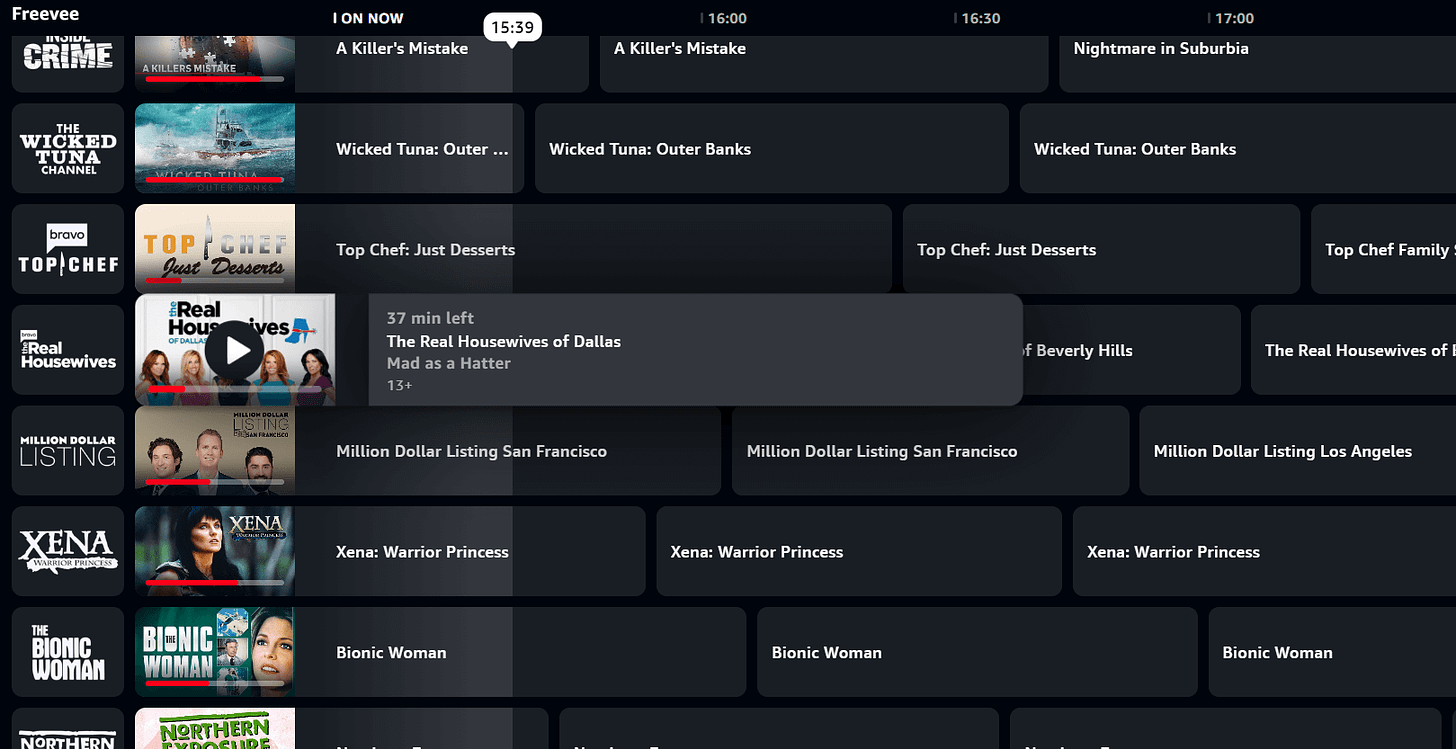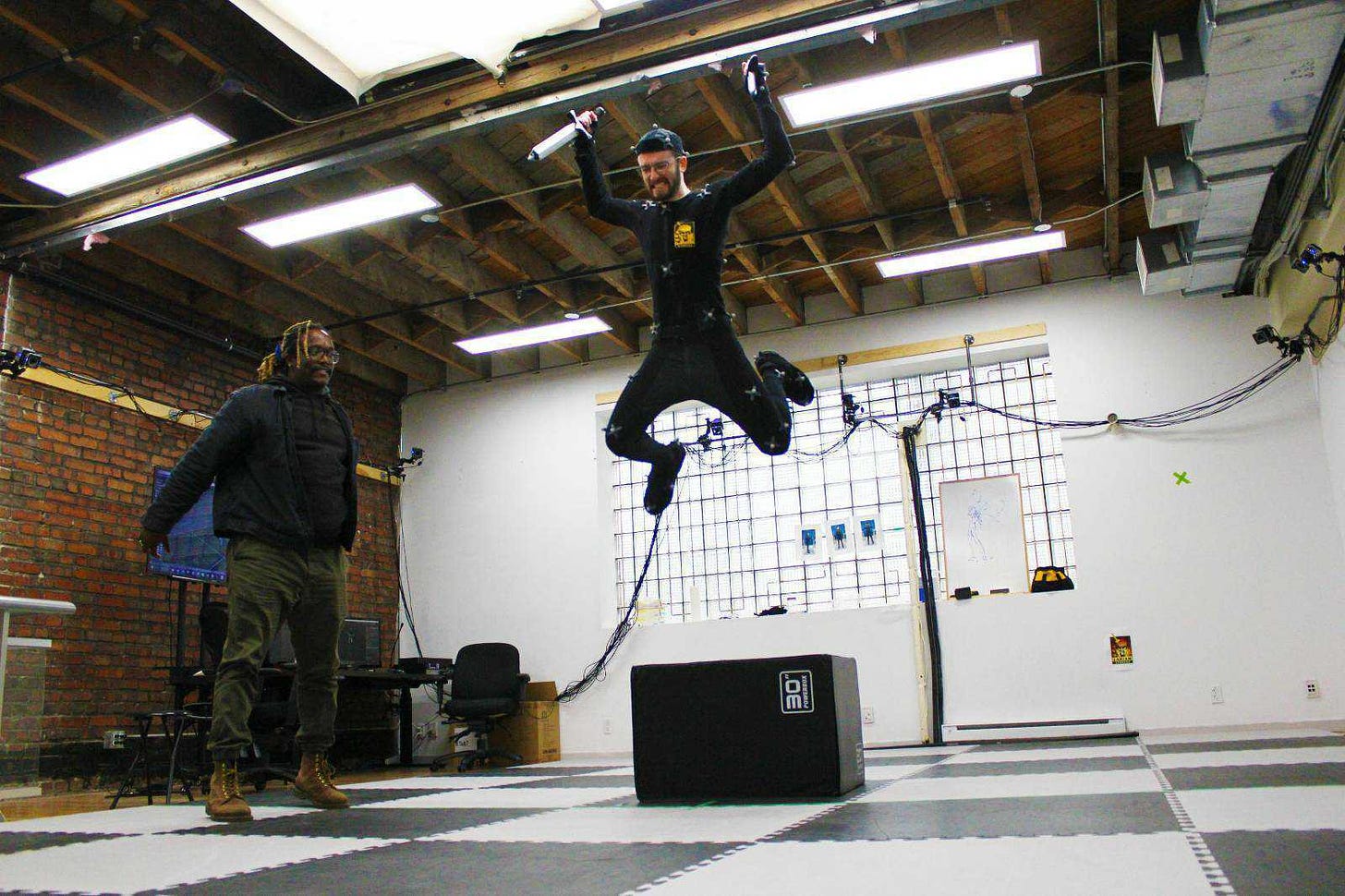Stuff Worth Knowing for the Week of August 28, 2023
Charter Communications cuts off Disney TV channels, CNN finds a new boss, and the iPad is finally getting a revamp.
Welcome back to Stuff Worth Knowing! Each week, I'll round up news related to tech, video games, film, television, anime, and more.
I return with a brand-new issue of the newsletter. The work trip beat my ass, but the news never stops. I didn’t intend to write an essay this week, but I had things to say about waves being made in the TV business.
Everything Old is New Again: Rebuilding the TV Business in Streaming
The business of Hollywood is in turmoil. All of the recent stories coming out of that sector of the entertainment industry boil down to two questions: Where is the money coming from? Where is it going? That’s at the heart of the dual Writers Guild of America (WGA) and Screen Actors Guild and American Federation of Television and Radio Artists (SAG-AFTRA) strikes. In chasing Netflix, the major studios have blown up a business model that at least partially worked, replacing it with one that’s confusing, even for the people at the top.
In the largest story this week, Disney found all of its linear networks cut off to Charter Spectrum customers. The cuts cover ABC, ESPN, FX, Freeform, and more on the second largest cable TV provider in the United States. The reason? It’s all about carriage fees. What are carriage fees? These are the fees that network owners like Disney charge cable TV distributors to run their networks.
Disney and Charter Communications are in the middle of negotiations, with Disney seemingly wanting an increase in carriage fees. (Disney says it merely offered an extension on the current contract.) An increase makes some sense for Disney, as linear TV is shrinking. Two weeks ago, Nielsen reported that broadcast and cable TV were seeing sharper declines year-over-year as streaming grows. Disney CEO Robert Iger noted back in July that there was the potential for the company to divest itself of its linear business, which includes ABC.
From a purely business perspective, the logic is solid: if the numbers are going down, then you want to make more per user. That’s likely what Disney floated to Charter Communications. The issue Disney has is one of timing: ESPN was running the U.S. Open when Charter cut it off and there are college football games going on as well. Live sports is a strong part of ESPN’s business, and at the moment, Charter customers are going without any of it.
Disney has had similar disputes in the past. The company’s networks disappeared on Dish Network and Sling TV last year, and dropped off of YouTube TV in 2021; in both cases, Disney eventually hammered out a deal. (Interestingly, YouTube TV has been floated by Charter customers as a potential fix during this current dispute.) HBO went entirely dark on Dish Network for three years over carriage fee disputes.
Making Money From Owning The Pipes
For companies like Disney the question remains: why would we give you a good deal when we can reach customers directly or through other means? While many viewers haven’t cut the cord, a number of them have. As an example, I personally watched the 2022 Winter Olympics on Peacock; on linear TV, I’m stuck at the whims of whatever event NBC is showing, but on streaming, I can watch any event at my leisure. It’s just better all around.
Network owners like Disney pondering this question is an existential problem for Charter, who told The Hollywood Reporter that it was willing to move away from video distribution altogether. “We’re on the edge of a precipice. We’re either moving forward with a new collaborative video model, or we’re moving on,” Charter CEO Chris Winfrey said on a conference call. “This is not a typical carriage dispute. It’s significant for Charter, and we think it’s even more significant for programmers and the broader video ecosystem.”
Sources told THR that Charter and Disney have talked about a “transformative” deal that could offer the latter company a way to reach consumers directly without torpedoing its linear business. Still, those talks have seemingly stalled, even as ESPN pursues new business models, bigger partnerships, and potentially a strong direct-to-consumer push in the future.
“When I talk about a glide path for Disney, it clears the way for ESPN to go direct-to-consumer in a way that’s friendly, and doesn’t completely cannibalize their larger linear video revenues that they have,” Winfrey said. “It also works for us because it creates a glide path for us to create new marketing channels for new types of video products. We respect the quality product that Disney produces and its management team. But the video ecosystem is broken.”
Charter is preparing for the loss of Disney programming to be permanent. Other cable providers are also weighing similar problems. Small regional providers like WOW and Frontier Cable have already moved to offering YouTube TV rather than traditional cable television. Verizon likewise offers YouTube TV directly as an option, if Fios users would rather go that route rather than its traditional cable service.
Rebuilding Pay TV In Streaming
On the other side of the conflict, companies like Disney, Warner Bros. Discovery, and Paramount are quickly rebuilding the older pay TV model, but in a direct-to-consumer streaming context. It’s not like subscription-based streaming isn’t making money, but it’s much harder to figure out who gets a piece of the pie.
Under the old ad-based model, you charge sponsors for views per ad based on how popular a show or programming block was. With streaming subscriptions, how do you determine who gets a cut of the subscription fee? Do you divide the $15 per month by everything that user watched that month? They might watch the latest season of Stranger Things, yes, but they’re also probably watching six seasons of Blown Away or Nailed It in the same month. And the former is far, far more expensive than the latter.
The subscription model also means companies keep everything in-house, holding viewership close to the chest rather than sharing those numbers with creatives. With ad-based models, the numbers need to be more public, because ad companies and networks need to agree on ad rates. Metric transparency for streamers is one of the demands that the WGA and SAG-AFTRA share, as this affects residual pay.
Slowly, the major companies are rebuilding the old ad model once again. Netflix, Disney+, and Max all have ad-supported tiers now, offering a lighter subscription fees at the cost of advertisements. (Netflix is actually turning to Nielsen to measure viewership for its ad tier.)
There’s also been a major growth in free ad-supported streaming television (FAST), which is basically the old linear TV model pushed through streaming. Services like Roku, Pluto TV, Tubi, and Amazon Freevee offer hundreds of free, themed channels that users can watch without a subscription. Warner Bros. Discovery has promised its own FAST service—rumored to be called WBTV—and some of its shows will be on Roku and Tubi as it spins up its own service.
“I see FAST as a replacement for the old syndication business,” Chicken Soup for the Soul Entertainment CEO Bill Rouhana told CNBC. “To also syndicate your content through FAST channels, that’s probably wisest. It could create strategic value in addition to just cash. In a world where churn is a fact, having the ability to show those lost subscribers content again and get money while doing it can only be good.” Rouhana’s company runs its own FAST offering, Redbox Free Live TV, and several ad-supported streaming services, including Redbox and Crackle.
Warner Bros. Discovery boss David Zaslav has also floated another method of recapturing the old pay TV model with streaming: bundling. While some bundles already exist like Disney’s Disney+/Hulu/ESPN+ package, Zaslav believes that intra-company bundles will eventually happen.
“For me, it seems very clear that if we were to package this great product that we have with others, if you were to wake up tomorrow and in each market the number one, two or three products, if we were marketed with two or three, for specific price, it would be great for consumers, it would probably reduce churn,” Zaslav said at an investor conference earlier this year, according to THR. “If we don’t do it to ourselves, I think it’ll be done to us.”
Will we see a Max/Paramount+/Peacock bundle in our future? Anything is possible. What’s clear is that, with bundling and ad-supported viewing, an entire industry has walked backwards while trying to look like it’s moving forward. We’ve cut the cord, only to collectively find our way back to the same model, because at the end of the day, that model somewhat worked. Everything old is new again.
Film, Television, and Streaming 🎞️
WGA and SAG-AFTRA Strikes: The Cuts and Delays Keep On Coming
There seems to be no end to the WGA and SAG-AFTRA strikes. This week, the studio heads met once again to try and push toward an end to the strikes. According to Deadline, Disney’s Dana Walden and Alan Bergman, Amazon Studios’ Mike Hopkins and Jennifer Salke, Netflix’s Ted Sarandos, Universal’s Donna Langley, and Warner Bros Discovery’s David Zaslav all attended a virtual meeting on the matter. Sadly, it doesn’t seem like there will be an end anytime soon.
Instead, studios are continuing to reassess the shows and films they already have in the pipeline. For some, this means cuts: Hulu canceled The Great and How I Met Your Father, while Disney+ said goodbye to Doogie Kamealoha, M.D. after two seasons.
For others, the answer is delays. HBO has moved True Detective: Night Country from 2023 to January 2024. Marvel Studios has moved everything except the second season of Loki: What If…? Season Two now premieres near Christmas Day, Echo has been moved to January 2024, the animated X-Men ’97 is early 2024, and Agatha: Darkhold Dairies is now aligned with Halloween 2024. Ironheart, Daredevil: Born Again, and Wonder Man are all indefinitely delayed, as the strikes are stopping their production entirely.
CNN’s New Boss is Former BBC and NYT Boss Mark Thompson
Following the firing of previous CNN boss Chris Licht, Warner Bros. Discovery has been looking for a new CEO. This week, the news network found a new leader in Mark Thompson. Thompson was previously the director-general of the BBC and president and CEO for the New York Times. “We face pressure from every direction — structural, political, cultural, you name it,” Thompson said in a statement to the Associated Press. “Like many other media organizations, CNN has recently felt some of the uncertainty and heartache that comes with all of that. There’s no magic wand I or anyone else can wield to make this disruption go away. But what I can say is that where others see threat, I see opportunity.”
Of course, Thompson is an old hand, and one wonders if that’s what CNN needs in 2023. The network is trying to move forward into a streaming future. Last week, CNN announced that it would launch a 24/7 live news service on Max, currently called CNN Max. This follows the quick shutdown of the standalone CNN+ service a single month after it launched.
Late Night Hosts Podcast To Support Their Staff
As the strikes stretch on, productions are halted, leaving many out-of-work. All of the major late night talk show hosts—Jimmy Fallon, Jimmy Kimmel, Seth Meyers, Stephen Colbert, and John Oliver—are banding together to alleviate the effects on their respective staffs. The hosts have begun a joint podcast called Strike Force Five on Spotify, with all sponsorship proceeds going to their staffers. What’s it about? The major late night hosts dealing with the strikes! Shocking, I know. Still, it’s a great way to support their staffers, so by all means.
Tech ⌨️
U.S. Government Restricts AI Chip Exports to the Middle East
According to Reuters, the U.S. government is restricting exports of chips meant for artificial intelligence work to regions like the Middle East. The details first appeared in a recent regulatory filing from Nvidia. “During the second quarter of fiscal year 2024, the USG informed us of an additional licensing requirement for a subset of A100 and H100 products destined to certain customers and other regions, including some countries in the Middle East,” said Nvidia in the document. Sources confirmed with Reuters that AMD received similar restrictions.
Nvidia has already skipped selling its A100 and H100 hardware in the restricted regions, instead going with its A800 and H800 products. There’s no specifications on the restrictions, nor which Middle Eastern regions are affected.
Apple Revamping the iPad Pro Next Year
The Apple iPad has entered a doldrum period, with sales for the third quarter of fiscal year 2023 coming in at $5.8 billion, down from $7.2 billion from the previous quarter year-over-year. The truth is the tablet has mostly been what it is for years now and Apple’s M series chips feel like they benefited the MacBook and Mac far more than the iPad.
According to Bloomberg’s Mark Gurman, Apple is making a few changes. The company will be changing up the iPad Pro, adding the new M3 chip and an OLED display. The updated Pro will come in two sizes, with 11-inch and 13-inch models. Apple is also planning a new Magic Keyboard, which will make the device look more like a laptop and sports a larger trackpad.
It’ll be a short wait before these updates drop, however. Apple’s next event, coming on September 12, will focus on the next iPhone and Apple Watch.
Meta May Allow EU Users to Pay to Avoid Advertisements
In response to increased scrutiny from European Union regulators, Meta may allow users in Europe to pay in order to skip advertisements. The story comes from the New York Times, whose sources have no further details about potential pricing. The change comes after German regulators won their case against Meta back in July, arguing that the social giant was collecting user data without their consent. Meta is likely to continue offering its free, ad-supported service in other regions, so don’t expect to get a “Facebook Premium” in the United States.
This Week In The Service Formerly Known as Twitter: Collecting Your Data
Earlier this week, Bloomberg noticed a brand-new privacy policy at the service formerly known as Twitter. The policy now allows the service to collect users’ biometric data for “safety, security, and identification purposes”. In addition, X may also collect employment history, educational history, and more for the new X Hiring service, which is planned as a competitor for LinkedIn. The “everything” app wants “everything” about its users.
Users being willing to give over all this data relies on a certain amount of trust in Musk’s platform. That trust will be in short supply, considering a recent European Commission report that Musk’s X has played a significant role in allowing Russian disinformation against the Ukraine to spread on social media. The report cites Musk’s dismantling of Twitter’s Safety team as a major issue.
Video Games 🎮
Embracer Group Shutters Volition
The house of cards has begun to fall. For years, we watched as Embracer Group purchased studios and IP with no concrete plan for the future. After borrowing significant sums to purchase everything, the bottom fell out on Embracer’s “model” when the Saudi Arabia-based Savvy Group declined to invest nearly $2 billion into the conglomerate. Now comes the austerity phase of Embracer Group, as it cuts and cuts to stay afloat.
Those cuts come at the expense of Volition, a studio that turned 30 years old this year. Following the poor launch of the Saints Row reboot and the previous failure of 2017’s Agents of Mayhem, time just ran out for the studio. The studio announced the news in a post on LinkedIn.
Sony Increases PlayStation Plus Pricing
Despite not particularly adding anything in terms of service offerings, Sony is increasing the price of its PlayStation Plus subscription service. (In fact, the company removed the PlayStation Plus Collection back in May.) The PlayStation Plus Essential subscription for 12 months jumps from $59.99 to $79.99, Extra goes from $99.99 to $134.99, and Premium goes from $119.99 to $159.99. The price changes will go in effect on September 6, though current subscribers can ride out the current prices until November 6.
Call of Duty Turns To AI For Voice Chat Moderation
This week, Activision announced that Call of Duty: Modern Warfare III would be utilizing AI for real-time voice chat moderation. The publisher is turning to a system called ToxMod, which will analyze live speech and ban offending users as necessary. The system will also roll out for Call of Duty: Modern Warfare II and Call of Duty: Warzone on August 30. The initial launch of ToxMod will begin in English, but Activision is planning to add other languages at a later date.
Layoffs and Labor 👷
SAG-AFTRA Sends Strike Authorization Vote To Game Performers
You may not realize it, but video game voice actors and performance capture folks are covered under SAG-AFTRA. The twist is they’re covered under a separate agreement, the Interactive Media Agreement. That agreement is up for bargaining on September 26, meaning if a deal is not reached, video game actors could join the existing strikes.
In preparation for such an outcome, SAG-AFTRA sent out a strike authorization vote to members covered under the Interactive Media Agreement this week. Like their television and film counterparts, the Interactive Media folks are seeking fair compensation and protections against AI.
“The voice and performance capture artists who bring video game characters to life deserve a contract that reflects the value they bring to the multibillion-dollar gaming industry. Voice and performance capture AI are already among the most advanced uses of AI: the threat is here and it is real. Without contractual protections, the employers are asking performers to unknowingly participate in the extinction of their artistry and livelihoods,” said SAG-AFTRA National Executive Director and Chief Negotiator Duncan Crabtree-Ireland.
Disney Visual Effects Workers Join Their Marvel Counterparts
This week, on-set visual effects workers within Walt Disney Pictures signed cards with the National Labor Relations Board, seeking to be represented by the International Alliance of Theatrical Stage Employees (IATSE). This follows the on-set visual effects workers at Marvel Studios making a similar decision a few weeks ago. A total of 18 employees at Walt Disney Pictures will likely join the 50 employees at Marvel Studios already seeking unionization.









